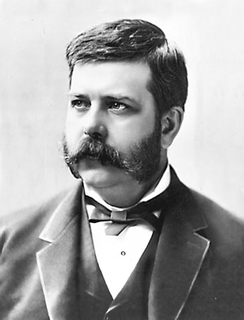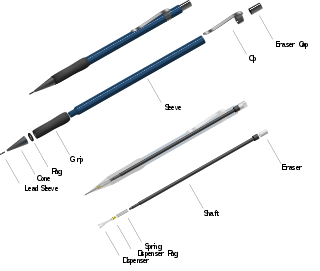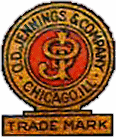
Charles Rood Keeran (April 16, 1883 - June 9, 1948) was an Illinois inventor and businessman.

Charles Rood Keeran (April 16, 1883 - June 9, 1948) was an Illinois inventor and businessman.
He was born on April 16, 1883, on a farm near Bloomington, Illinois. Having an inventive father, William Lee Keeran, C.R. Keeran grew up with a creative spirit. After achieving a master's degree in engineering, he soon began patenting his ideas (circa 1906) which continued throughout his lifetime:
Keeran's 2-piece vacuum seal for Mason jars, which became the standard for home-canning, was immediately popular. However, he sold off his company, White Crown Fruit Jar, in order to finance his favorite invention: the Eversharp mechanical pencil. Around 1914, Keeran invented the basic mechanism for the Eversharp, thought up the "Eversharp" trademark (inspired by the Winchester Rifle logo), and set up a company to make and sell Eversharp pencils. He relocated to Evanston, Illinois, and entered into a business alliance with the Wahl Adding Machine Company in Chicago. Wahl officers obtained a majority share in the Eversharp Pencil Company and, in 1917, forced Keeran out of the company.
In 1919, Keeran registered the "Autopoint" trademark. In 1921, Keeran joined three businessmen in the Realite Pencil Company. Keeran brought the Autopoint name with him. Within a few years the company was renamed, the Autopoint Company.
Keeran felt that his invention and suggestions during his association with Wahl were the basis of their prosperity. For years, he fought a battle to get just compensation from the Wahl Company. [1] He got no satisfaction.
He died on June 9, 1948, in Chicago, Illinois. [2]

An invention is a unique or novel device, method, composition or process. The invention process is a process within an overall engineering and product development process. It may be an improvement upon a machine or product or a new process for creating an object or a result. An invention that achieves a completely unique function or result may be a radical breakthrough. Such works are novel and not obvious to others skilled in the same field. An inventor may be taking a big step toward success or failure.

George Westinghouse Jr. was an American entrepreneur and engineer based in Pennsylvania who created the railway air brake and was a pioneer of the electrical industry, receiving his first patent at the age of 19. Westinghouse saw the potential of using alternating current for electric power distribution in the early 1880s and put all his resources into developing and marketing it. This put Westinghouse's business in direct competition with Thomas Edison, who marketed direct current for electric power distribution. In 1911 Westinghouse received the American Institute of Electrical Engineers's (AIEE) Edison Medal "For meritorious achievement in connection with the development of the alternating current system."

Cyrus Hall McCormick was an American inventor and businessman who founded the McCormick Harvesting Machine Company, which later became part of the International Harvester Company in 1902. Originally from the Blue Ridge Mountains of Virginia, he and many members of the McCormick family became prominent residents of Chicago.
Within the context of a national or multilateral body of law, an invention is patentable if it meets the relevant legal conditions to be granted a patent. By extension, patentability also refers to the substantive conditions that must be met for a patent to be held valid.

A mechanical pencil, also clutch pencil, is a pencil with a replaceable and mechanically extendable solid pigment core called a "lead". The lead, often made of graphite, is not bonded to the outer casing, and can be mechanically extended as its point is worn away as it is being used. Other names include microtip pencil, automatic pencil, drafting pencil, technical pencil, click pencil, pump pen, pump pencil, leadholder, pacer, propelling pencil, pen pencil, and lead pencil.
The Autopoint Company was a manufacturer of pencils and desk top accessories in Chicago for about 50 years from the 1920s to around 1970.
John P. Lynn was a Chicago businessman.
This is a list of legal terms relating to patents. A patent is not a right to practice or use the invention, but a territorial right to exclude others from commercially exploiting the invention, granted to an inventor or his successor in rights in exchange to a public disclosure of the invention.
John Karmazin Sr. was an American engine component inventor and business founder.

Inventions and Their Management is a science book by Alf K. Berle and L. Sprague de Camp. It was based on A Course on Inventing and Patenting by Howard Wilcox and Alf K. Berle, a series of nine papers presented by New York University in cooperation with Inventors Foundation, Inc., issued from 1933-1934. The Berle/de Camp version was published by the International Textbook Company in July 1937. It was reprinted, revised, in September 1940. A second edition was issued by the same publisher in April 1947 and was reprinted, revised, in January 1948, with a third printing in June 1948 and a fourth in June 1950. A third edition was issued by the same publisher in November 1951 and was reprinted, revised, in 1954. An additional printing was issued by Laurel Publishing in 1957. The work was revised and reissued under the new title Inventions, Patents, and Their Management by Van Nostrand in 1959. It was reprinted by Litton Educational publishers in 1968. The work has been translated into Japanese.
The Mills Novelty Company, Incorporated of Chicago was once a leading manufacturer of coin-operated machines, including slot machines, vending machines, and jukeboxes, in the United States. Between about 1905 and 1930, the company's products included the Mills Violano-Virtuoso and its predecessors, celebrated machines that automatically played a violin and, after about 1909, a piano. By 1944, the name of the company had changed to Mills Industries, Incorporated. The slot machine division was then owned by Bell-O-Matic Corporation. By the late 1930s, vending machines were being installed by Mills Automatic Merchandising Corporation of New York.

Jennings & Company was a leading manufacturer of slot machines in the United States and also manufactured other coin-operated machines, including pinball machines, from 1906 to the 1980s. It was founded by Ode D. Jennings as Industry Novelty Company, Incorporated of Chicago. On the death of its founder in 1953, the company was succeeded by Jennings & Company.
Hotchkiss v. Greenwood, 52 U.S. 248 (1851), was a United States Supreme Court decision credited with introducing into United States patent law the concept of non-obviousness as a patentability requirement, as well as stating the applicable legal standard for determining its presence or absence in a claimed invention.
Eversharp is an American brand of writing implements founded by Charles Rood Keeran in 1913 and marketed by Keeran & Co., based in Chicago. Keeran commercialised Eversharp mechanical pencils, then expanding to fountain pens when the company was acquired by the Wahl Adding Machine Co. in 1916 and it was named "Wahl-Eversharp". The company continued until 1957 when it was acquired by Parker Pen, which continued to use the Eversharp brand for a time.

The United States provided many inventions in the time from the Colonial Period to the Gilded Age, which were achieved by inventors who were either native-born or naturalized citizens of the United States. Copyright protection secures a person's right to his or her first-to-invent claim of the original invention in question, highlighted in Article I, Section 8, Clause 8 of the United States Constitution, which gives the following enumerated power to the United States Congress:
To promote the Progress of Science and useful Arts, by securing for limited Times to Authors and Inventors the exclusive Right to their respective Writings and Discoveries.

A patent holder in Canada has the exclusive right, privilege and liberty to making, constructing, using and selling the invention for the term of the patent, from the time the patent is granted. Any person who does any of these acts in relation to an invention without permission of the patent owner is liable for patent infringement.

Abraham Lincoln's patent relates to an invention to buoy and lift boats over shoals and obstructions in a river. Abraham Lincoln conceived the invention when on two occasions the boat on which he traveled got hung up on obstructions. Lincoln's device was composed of large bellows attached to the sides of a boat that were expandable due to air chambers. Filed on March 10, 1849, Lincoln's patent was issued as Patent No. 6,469 later that year, on May 22. His successful patent application led to his drafting and delivering two lectures on the subject of patents while he was president.
Rubber-Tip Pencil Co. v. Howard, 87 U.S. 498 (1874), is an 1874 decision of the United States Supreme Court concerning the patent eligibility of abstract ideas. As explained below in the Subsequent developments section, it is intermediate in the development of that aspect of patent law from Neilson v Harford, through O'Reilly v. Morse, to Funk Bros. Seed Co. v. Kalo Inoculant Co., and then to Parker v. Flook, Mayo Collaborative Servs. v. Prometheus Labs., Inc., and Alice Corp. v. CLS Bank Int'l.
James Dalton Cunningham was an American manufacturer, president of the Republic Flow Meters Co. in Chicago, and inventor, who served as the 69th president of the American Society of Mechanical Engineers.
Wilbur Hering Armacost, Jr. was an American mechanical engineer, vice president-consultant of Combustion Engineering, Inc., New York, and inventor. He is known as pioneer developer of materials adaptable to high temperatures and pressure, and designer of high-temperature high-pressure steam engines. He was recipient of the 1958 ASME Medal for distinguished service in engineering and science.
The funeral of Charles Rood Keeran, 65, who was associated for many years with the mechanical pencil, will be held at 2:30 p.m. Saturday in the chapel at ...